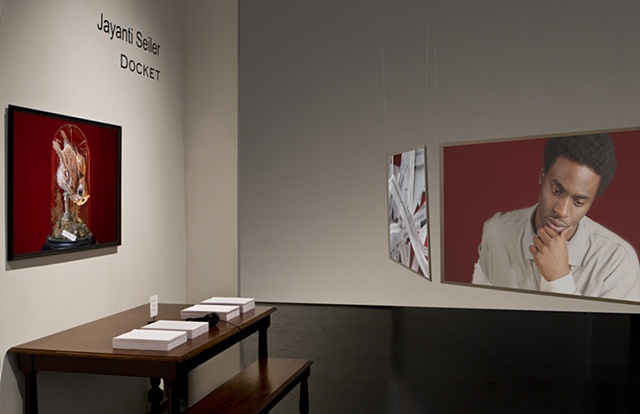Video and Installation Stills (2009-11)
Image: Docket Video Installation (2009-11)
View the full-length video on the Links page
Docket is a film exhibited as a two-channel video installation, that I created to heighten awareness about abuses that unwittingly occur in the child welfare system. In 2010, I became a Guardian ad Litem (GAL) volunteer in Alachua County, a court appointed advocate for children that have been brought into the court system due to abuse and neglect. The video explores the discrepancies in a system created for provision and protection, but incongruously victimizes and renders children voiceless. It was designed to heighten awareness about abuses that unwittingly occur in the child welfare system by implicating its construction, methods of translation and redacted histories. The monologues of former foster children and service providers that worked with them are placed up against one another on a screen juxtaposed with close ups of hands manipulating strips of paper containing the formal language of the system. The content of the text stands in opposition to the candid stories and insights that people share as they engage directly with the audience by way of the camera.
In creating a formally rigorous visual presentation that isolates the subjects against a red background and removing the process of intervention by allowing people to speak alone with the camera, emphasis is placed on the voice of the individual that is also part of a larger systematic structure. In this way, the piece addresses problematic forms of representation used in social documentary practices by implementing strategies that dilute the authority of the medium of video and photography. Additionally, the installation contains a table with four separate three inch stacks of found poetry generated from legal templates and court documents. Next to these is an audio piece consisting of a woman’s voice instructing a young child to recite narratives from court documents in Russian. A photograph sharing the aesthetic of the video monologues is mounted above the desk, depicting a glass enclosed taxidermied owl specimen that embodies the project’s central motivation. Geared to look critically at the limitations of social documentary photography, I chose strategies to best illuminate the underlying commonly held value that it is acceptable to not only treat children in often demeaning if not criminal ways which have become legitimatized under the guise of protection, but animals as well. By intervening in my own process as image maker, depoliticizing the photographic agenda and acknowledging the inadequacies of representation, I want to infuse this subject matter with a new level of dignity and promote social awareness. It is my hope that this piece will not only empower the participants, but also help drive the incentive for change in the child welfare system.
